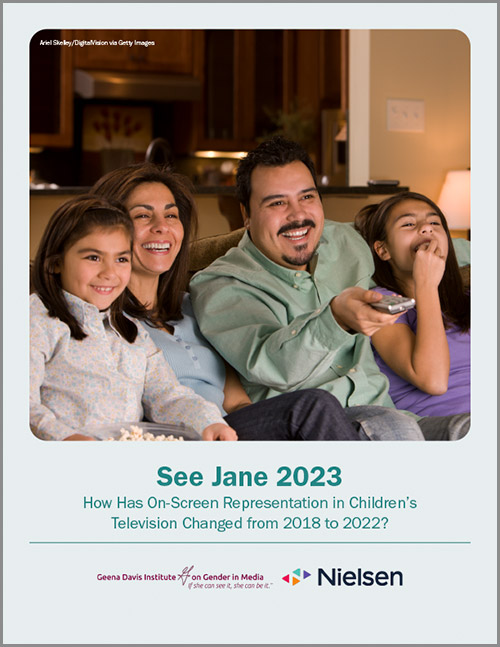
Since 2004, the Geena Davis Institute has advocated for greater on-screen inclusion and better representation in global entertainment media through research and advocacy. To continue this effort, we analyzed two different types of children’s media content for the inclusion and representation of six categories—gender, race, LGBTQIA+ identity, disability, age, and body size—and characters’ intersections therein. First, we looked at inclusion and representation of these identities in programming popular with children ages two to 11 in the U.S. according to Nielsen metrics, which includes the 10 most popular broadcast, cable, and streaming shows, inclusive of all languages, to give us a sense of what children are watching. Second, we analyzed inclusion and representation in new children’s programming, which is TV that is currently being made for children, to give us a sense of what is being made for children. These were a summary of the main findings:
- Most shows that children are watching have a female lead. But female characters are about 44% of leads in new shows being made for kids.
- Female characters are underrepresented in animation.
- Characters of color occupy a record number of leading roles.
- LGBTQIA+ and disabled representation remains very low.
- Disabled representation lacks racial diversity.
- Fat characters are much more often male than female.
Recommendations
- Hire more girls, women and nonbinary people to voice nonhuman characters, like ghosts, aliens, monsters, and talking objects. Animated characters, especially those who are nonhuman, are mostly voiced by male actors. Adding more gender diversity to these nonhuman animated characters will provide audiences with more dynamic portrayals of female characters, and create more gender equality in children’s programming. Because it is common practice for one actor to voice many animated characters in one show, it is important to strive for behind-the-scenes parity. Bringing in more female and nonbinary voice actors can drastically increase the proportion of female and nonbinary characters.
- Cast girls and women in minor roles, too. This report finds steady representation of female characters in leading roles, which is helping to drive positive change toward gender parity on-screen. But girls/women still lag behind boys/men overall, and this is due in part to male characters occupying nearly 2 out of 3 minor roles. To reach gender parity, we need to see female characters in roles at all levels, including supporting roles, minor roles, and extras. There’s no reason fictional stories shouldn’t accurately reflect the real-world population — which is particularly true for the shows children watch.
- Increase the visibility of diverse queer characters. Queer characters (especially nonbinary characters) are more likely to be white and young. Historically, the intersection of racism with homophobia and transphobia has led to the erasure of LGBTQIA+ people of color in entertainment media, which can limit the perception of queer diversity and the acceptance of queerness in communities of color. Furthermore, the fallacy that only young people are LGBTQIA+ contributes to narratives that queerness is a “fad” that people may “grow out of.” Cast queer characters of all races and ages to better reflect queer identity in the real world.
- Increase the representation of disabled young people on-screen. About 4% of young people under 18 in the U.S. have a developmental disability, and nearly 20% have mental health issues, according to the Centers for Disease Control and Prevention. However, disabled representation is rare in children’s programming, and when it is shown, it’s more likely to be a disabled adult on-screen. Bring more diverse disability portrayals to the screen by casting more young people with disabilities, such as limb differences or hearing or vision impairments, and by telling more stories about disabled characters of all ages. Seeing yourself on-screen can be powerful, especially for disabled children.
- Diversify live-action characters. In this study, we find more racial diversity among animated characters than live-action characters. While we celebrate this diversity in animation, it is important to make improvements in live-action television as well. Adding more live-action characters of color increases the number of opportunities for actors of color and increases the number of characters for young children of color to relate to.
- Allow characters of different backgrounds to express themselves and talk about their feelings. Very few young characters were shown talking about their feelings. Given that the majority of these shows are made for children, we would hope to see more emotional maturity modeled for young viewers. Show characters of all backgrounds modeling this behavior, thus challenging stereotypes that frame the expression of feelings as weak or reserved for only certain groups of people, like children or women.
Photo credit: Ariel Skelley/DigitalVision via Getty Images

